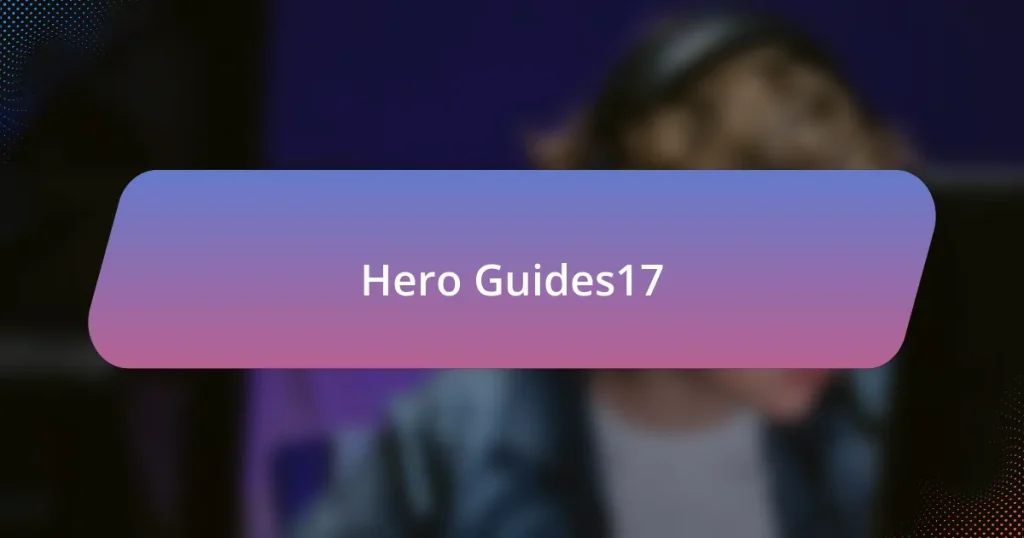Hero abilities in Dota 2 are unique skills that each hero possesses, consisting of active, passive, and ultimate abilities that significantly influence gameplay. This article explores how these abilities define a hero’s role, impact team composition, and shape strategies throughout a match. It delves into the mechanics of hero abilities, including cooldowns and mana costs, and discusses the evolution of these abilities as heroes progress. Additionally, the article addresses common misconceptions about hero abilities and offers tips for players to enhance their understanding and mastery of these crucial gameplay elements.

What are Hero Abilities in Dota 2?
Hero abilities in Dota 2 are unique skills that each hero possesses, allowing them to perform specific actions and influence the game. These abilities typically include a combination of active and passive skills, which can deal damage, provide utility, or enhance the hero’s attributes. Each hero has four abilities: three basic abilities and one ultimate ability, which is usually more powerful and has a longer cooldown. The design of these abilities is crucial to the gameplay, as they define the hero’s role and strategy within the match.
How do Hero Abilities influence gameplay?
Hero abilities significantly influence gameplay by determining a hero’s role, strengths, and strategies within Dota 2. Each hero possesses unique abilities that can affect damage output, crowd control, healing, and mobility, which in turn shapes team compositions and tactics. For instance, heroes with strong crowd control abilities can disrupt enemy movements and secure kills, while those with healing abilities can sustain their team during engagements. The synergy between different hero abilities can create powerful combinations, enhancing overall team effectiveness. This dynamic interaction is crucial, as it dictates how players approach objectives, engage in fights, and adapt their strategies throughout the match.
What are the different types of Hero Abilities?
Hero abilities in Dota 2 are categorized into three main types: Active Abilities, Passive Abilities, and Ultimate Abilities. Active Abilities require the player to manually activate them, often having immediate effects such as dealing damage or providing buffs. Passive Abilities automatically trigger under certain conditions without player input, enhancing a hero’s stats or providing effects like lifesteal or evasion. Ultimate Abilities are powerful skills that typically have longer cooldowns and significant impacts on gameplay, often defining a hero’s role in a match. Each type plays a crucial role in shaping the strategies and dynamics of gameplay in Dota 2.
How do Hero Abilities interact with each other?
Hero abilities in Dota 2 interact through various mechanics such as synergy, counterplay, and status effects. For instance, certain abilities can amplify the effects of others; for example, a hero’s crowd control ability can set up a follow-up damage ability from an ally, maximizing damage output. Additionally, some abilities can negate or counteract others, like a dispel ability removing buffs or debuffs, which can significantly alter the course of a battle. The interaction between abilities is crucial for strategic gameplay, as players must consider how their hero’s abilities work in conjunction with or against those of their teammates and opponents.
Why are Hero Abilities essential for strategy?
Hero abilities are essential for strategy because they define a hero’s role and influence gameplay dynamics. Each ability provides unique advantages, such as crowd control, damage output, or healing, which can significantly alter the course of a match. For instance, in Dota 2, heroes like Pudge utilize abilities that can initiate fights or secure kills, while others like Dazzle offer healing and support, showcasing how diverse abilities contribute to team composition and tactics. The strategic use of these abilities allows teams to execute coordinated attacks, defend against opponents, and adapt to evolving game situations, making them a fundamental aspect of competitive play.
How do players choose Heroes based on their abilities?
Players choose Heroes based on their abilities by evaluating how those abilities align with their preferred playstyle and the needs of their team. Each Hero in Dota 2 possesses unique skills that can influence the game’s outcome, such as crowd control, damage output, or healing capabilities. For instance, a player may select a Hero with strong area-of-effect damage to counter a clustered enemy team or choose a support Hero with healing abilities to sustain allies during fights. This strategic selection is often informed by the current meta, which highlights the effectiveness of certain Heroes in the prevailing game environment. Additionally, players consider synergy with teammates’ Heroes and the overall composition of both teams to maximize their chances of victory.
What role do Hero Abilities play in team composition?
Hero abilities are crucial in team composition as they define the strategic roles and synergies within a team. Each hero’s abilities contribute to the overall effectiveness of the team by providing unique strengths, such as crowd control, damage output, healing, or utility. For example, a hero with strong area-of-effect damage can complement a team that excels in grouping enemies, while a hero with healing abilities can sustain the team during prolonged engagements. The combination of these abilities influences the team’s strategy, allowing for diverse approaches to combat and objectives. This synergy is essential for maximizing the team’s potential and achieving victory in Dota 2.

How are Hero Abilities categorized?
Hero abilities in Dota 2 are categorized into three main types: Active Abilities, Passive Abilities, and Ultimate Abilities. Active Abilities require the player to manually activate them, often having a cooldown period, while Passive Abilities automatically trigger under certain conditions without player input. Ultimate Abilities are powerful skills that typically have longer cooldowns and can significantly impact the game, often defining a hero’s role in team fights. This categorization helps players understand the strategic use of each ability in gameplay.
What are the main categories of Hero Abilities?
The main categories of Hero Abilities in Dota 2 are Active Abilities, Passive Abilities, and Ultimate Abilities. Active Abilities require the player to manually activate them, often resulting in immediate effects such as dealing damage or providing buffs. Passive Abilities automatically trigger under certain conditions without player input, enhancing a hero’s capabilities or providing unique effects. Ultimate Abilities are powerful skills that typically have longer cooldowns and significant impacts on gameplay, often defining a hero’s role in team fights. These categories are essential for understanding the strategic depth and mechanics of Dota 2.
What defines a Passive Ability?
A Passive Ability is defined as a skill or effect that operates automatically without requiring active input from the player. In Dota 2, these abilities enhance a hero’s performance or provide benefits continuously or under specific conditions, such as increasing damage, providing healing, or granting additional effects during combat. For example, the ability “Berserker’s Blood” from the hero Lifestealer increases his damage and attack speed based on his missing health, illustrating how passive abilities can significantly influence gameplay without direct activation.
What defines an Active Ability?
An Active Ability is defined as a skill or power that a hero can use during gameplay, requiring player activation to trigger its effects. These abilities typically have specific conditions for use, such as a cooldown period or resource cost, and can significantly influence the outcome of battles by providing offensive, defensive, or utility effects. In Dota 2, Active Abilities are integral to gameplay strategy, as they allow players to execute complex maneuvers and respond dynamically to opponents, thereby shaping the flow of the game.
How do Ultimate Abilities differ from regular abilities?
Ultimate Abilities are distinct from regular abilities primarily in their power and usage frequency. While regular abilities can be used multiple times throughout a match, Ultimate Abilities are typically more powerful and can only be used once certain conditions are met, such as a cooldown period or resource requirements. For example, in Dota 2, Ultimate Abilities often have significant game-changing effects, such as altering the course of a team fight or providing substantial buffs, which is not the case for most regular abilities that tend to have more limited impacts. This differentiation is crucial for strategic gameplay, as players must manage their use of Ultimate Abilities carefully to maximize their effectiveness in critical moments.
What are the characteristics of Ultimate Abilities?
Ultimate Abilities in Dota 2 are powerful skills that significantly impact gameplay and often define a hero’s role in a match. These abilities typically have long cooldowns, high mana costs, and can turn the tide of battle due to their game-changing effects. For instance, many Ultimate Abilities can deal massive damage, control enemies, or provide substantial buffs to allies. The strategic use of these abilities is crucial, as they can alter the dynamics of team fights and objectives.
How do Ultimate Abilities impact the game at critical moments?
Ultimate Abilities significantly influence the outcome of critical moments in Dota 2 by providing powerful effects that can turn the tide of battle. These abilities often have game-changing impacts, such as dealing massive damage, controlling enemy movements, or providing significant buffs to allies. For instance, an Ultimate Ability like Black Hole from Enigma can incapacitate multiple enemies, allowing teammates to capitalize on the situation and secure kills or objectives. The timing and execution of these abilities are crucial; using them effectively during team fights can lead to a decisive advantage, as evidenced by professional matches where well-timed Ultimates have swung the momentum in favor of a team, often resulting in victory.

What are the mechanics behind Hero Abilities?
Hero abilities in Dota 2 operate through a combination of cooldowns, mana costs, and unique effects that define each hero’s role and strategy in gameplay. Each ability has specific parameters, such as range, damage, and status effects, which influence how they interact with opponents and allies. For instance, abilities can be classified into active and passive types, with active abilities requiring player input to trigger, while passive abilities automatically activate under certain conditions. Additionally, abilities can scale with levels, enhancing their effectiveness as the hero progresses in the game. The mechanics of hero abilities are crucial for strategic planning, as they dictate the timing and execution of actions during matches.
How do cooldowns affect Hero Abilities?
Cooldowns directly limit the frequency with which hero abilities can be used in Dota 2. Each ability has a specific cooldown period that begins after the ability is cast, during which the ability cannot be activated again. This mechanic forces players to strategize their ability usage, as timing becomes crucial in both offensive and defensive scenarios. For example, a hero with a powerful ultimate ability may have a long cooldown, meaning players must wait a significant amount of time before they can use it again, impacting their overall effectiveness in fights. The cooldown system ensures that abilities are not spammed, promoting tactical gameplay and resource management.
What is the significance of ability cooldowns in combat?
Ability cooldowns in combat are significant because they regulate the frequency with which a hero can use their abilities, thereby influencing strategic decision-making and resource management. Cooldowns create a tactical layer in gameplay, requiring players to time their abilities effectively to maximize impact during engagements. For instance, in Dota 2, many powerful abilities have long cooldowns, compelling players to coordinate with teammates and plan their actions around these limitations to secure advantages in battles. This mechanic ensures that no single ability can dominate combat, promoting a balanced and dynamic gameplay experience.
How do players manage cooldowns during gameplay?
Players manage cooldowns during gameplay by strategically timing their abilities and coordinating with teammates. Effective cooldown management involves understanding the duration of each ability’s cooldown and anticipating when to use them for maximum impact. Players often track cooldowns visually through the user interface and mentally by keeping a mental note of their abilities and those of their opponents. This allows them to engage in battles when their abilities are available and retreat or play defensively when they are not. Additionally, players may use items that reduce cooldowns or enhance their abilities, further optimizing their gameplay strategy.
What is the role of mana in using Hero Abilities?
Mana is a resource required to activate hero abilities in Dota 2. Each ability has a specific mana cost, which must be met for the ability to be used. This system ensures that players must manage their mana effectively, balancing the use of abilities with the need to conserve mana for critical moments in gameplay. For example, a hero may have powerful abilities that can turn the tide of battle, but if their mana is depleted, they cannot utilize these abilities, limiting their effectiveness in combat.
How does mana cost influence ability usage?
Mana cost directly influences ability usage by determining how frequently a player can cast abilities during a match. In Dota 2, each ability has a specific mana cost that must be paid to use it, which directly impacts a hero’s strategic options and overall effectiveness in gameplay. For instance, if a hero has a high mana cost ability, the player must manage their mana pool carefully, often leading to more strategic decision-making about when to engage in fights or use abilities. This is evidenced by the fact that heroes with low mana costs can use their abilities more liberally, allowing for sustained pressure on opponents, while those with high mana costs may need to conserve resources, limiting their impact in skirmishes.
What strategies can players use to manage mana effectively?
Players can manage mana effectively by utilizing abilities and items that enhance mana regeneration and by making strategic decisions about ability usage. For instance, players should prioritize using abilities that have low mana costs during engagements to conserve resources for critical moments. Additionally, items like Arcane Boots and Eul’s Scepter of Divinity provide significant mana regeneration and can be used strategically to replenish mana during fights. Effective communication with teammates about mana status can also help coordinate ability usage, ensuring that players do not overextend without sufficient mana.
How do Hero Abilities evolve throughout a match?
Hero abilities evolve throughout a match by increasing in power and effectiveness as heroes gain experience and levels. As heroes level up, they unlock new abilities and enhance existing ones, which significantly impacts their role in team fights and overall strategy. For example, in Dota 2, heroes typically have four abilities: three basic abilities and one ultimate ability. The ultimate ability usually becomes available at level six, providing a significant boost to a hero’s capabilities. Additionally, as heroes progress to higher levels, they can invest skill points into their abilities, increasing damage, reducing cooldowns, or adding new effects. This evolution is crucial for adapting to the changing dynamics of the match, allowing heroes to counter opponents and capitalize on their strengths as the game progresses.
What factors contribute to the progression of Hero Abilities?
The progression of Hero Abilities in Dota 2 is primarily influenced by experience points, level advancement, and skill choices. Experience points are gained through various actions such as defeating enemy heroes, creeps, and structures, which contribute to leveling up the hero. As a hero levels up, players can allocate skill points to enhance or unlock abilities, directly impacting the hero’s effectiveness in gameplay. Additionally, the choice of skills can vary based on the player’s strategy and the game’s context, further influencing how abilities progress and are utilized throughout the match.
How do item builds enhance Hero Abilities?
Item builds enhance Hero abilities by providing specific attributes, effects, and synergies that amplify a Hero’s strengths or mitigate weaknesses. For instance, items like Aghanim’s Scepter can modify a Hero’s ultimate ability, granting new effects or improving its power, while items such as Black King Bar provide spell immunity, allowing Heroes to execute their abilities without interruption. This strategic selection of items directly influences gameplay, as the right combination can significantly increase a Hero’s effectiveness in various situations, leading to improved performance in battles and objectives.
What are common misconceptions about Hero Abilities?
Common misconceptions about Hero Abilities in Dota 2 include the belief that all abilities scale equally with levels and items, which is incorrect. In reality, each ability has its own scaling mechanics, often influenced by specific attributes or item interactions. For instance, some abilities may have fixed damage or effects that do not increase with level, while others may scale significantly with certain items, such as damage amplification from critical strike items. Additionally, players often misunderstand the cooldowns of abilities, assuming they are uniform across all heroes, when in fact, cooldowns vary widely and can be reduced by specific items or talents. This misunderstanding can lead to ineffective gameplay strategies and missed opportunities in matches.
How do players often misunderstand ability synergies?
Players often misunderstand ability synergies by failing to recognize how certain abilities interact with each other in complex ways. For instance, many players may overlook the importance of timing and positioning when combining abilities, leading to ineffective execution during gameplay. Additionally, players might assume that any two abilities from different heroes will automatically create a powerful combination, disregarding the specific mechanics and conditions required for optimal synergy. This misunderstanding can result in missed opportunities for maximizing damage output or crowd control, ultimately affecting team performance in matches.
What are the pitfalls of over-relying on specific abilities?
Over-relying on specific abilities can lead to a lack of adaptability and strategic flexibility in gameplay. When players focus excessively on a single ability, they may neglect the importance of utilizing a hero’s full skill set, which can result in predictable gameplay and vulnerability to counter-strategies. For instance, in Dota 2, heroes like Invoker possess multiple abilities that can be combined for greater effectiveness; failing to use this versatility can diminish a player’s impact in matches. Additionally, over-reliance can create a dependency that hinders skill development, as players may not practice or learn to execute other crucial tactics or abilities, ultimately limiting their overall effectiveness in diverse game scenarios.
What tips can improve understanding of Hero Abilities?
To improve understanding of Hero Abilities in Dota 2, players should actively engage in practice matches to experience abilities firsthand. This hands-on approach allows players to see the effects of each ability in real-time, enhancing comprehension of their mechanics and interactions. Additionally, studying ability tooltips and descriptions provides crucial information about damage, cooldowns, and effects, which are essential for strategic planning. Watching professional gameplay or tutorials can also offer insights into effective ability usage and positioning, showcasing how experienced players leverage abilities in various scenarios. Finally, discussing strategies with other players can deepen understanding through shared experiences and tactics.
How can players practice effectively to master Hero Abilities?
Players can practice effectively to master Hero Abilities by utilizing targeted training methods such as focused gameplay, ability cooldown management, and reviewing gameplay footage. Focused gameplay involves selecting a specific hero and repeatedly practicing their abilities in various scenarios, which helps in understanding timing and positioning. Ability cooldown management is crucial; players should learn to optimize their ability usage to maximize impact during engagements. Reviewing gameplay footage allows players to analyze their performance, identify mistakes, and refine their strategies. These methods are supported by the fact that consistent practice and analysis lead to improved skill levels in competitive gaming environments.
What resources are available for learning about Hero Abilities?
Resources available for learning about Hero Abilities in Dota 2 include the official Dota 2 website, which provides detailed descriptions of each hero’s abilities, and community-driven platforms like DotaBuff and Liquipedia, which offer statistics and guides. Additionally, YouTube channels and Twitch streams dedicated to Dota 2 gameplay often feature tutorials and breakdowns of hero abilities in action. These resources are widely recognized within the Dota 2 community for their accuracy and depth of information, making them reliable for players seeking to enhance their understanding of hero mechanics.











